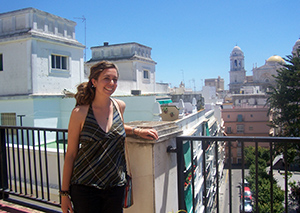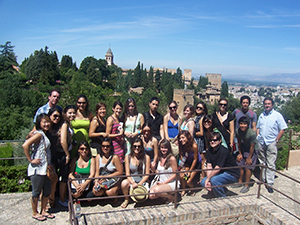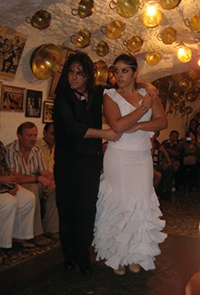Learning to Love Flamenco and the Spanish Way of Life
Cristina Farkas | July 13, 2009

Cristina Farkas poses for a snapshot after arriving in Spain.
Hola from Cádiz, España! I’ve been here studying for almost a week, in the 3,000-year-old city called Cádiz, with the linguistics Global Seminar on Spanish Dialectology and the Art, Culture and History of Flamenco. It is such a privilege to study both Spanish dialects and flamenco in this port city, which was instrumental to both the golden age of flamenco and Spain’s exploration in the New World. The seminar lasts one month, so I have tried to immediately immerse myself in the Spanish way of life, which has led to both education and self discovery!
Our classes are in English and are conducted by John Moore, a UC San Diego professor of linguistics, but I have had plenty of opportunities to practice speaking Spanish. I am asking for directions or recommendations as I explore my new home; I have already begun saying “gra-thee-a”, gracias, and “Val-ay”, vale, for thank you and okay. Spanish here is different from the language spoken in Latin America, so I am not only learning new vocabulary, but also new pronunciation.

Students in the Global Seminar on Spanish Dialectology and the Art, Culture and History of Flamenco pose for a group picture.
The great part about the global seminar is that we have the opportunity to go on excursions relevant to our classes. Last Friday, the class was led through a barrio in Santa Maria, the traditional gitano (gypsy) neighborhood of Cádiz, in a walking tour about important flamencos and the development of the music. Our guide was dressed in brightly colored polka dot skirt with a large rose in her hair, and as she sang her Alegrías, we traveled along the cobblestone streets, and were introduced to the business and music of the neighborhood from the 17th century to today. The singing in flamenco is an acquired taste, but I enjoy watching the cooperation between the toque, cante, baile and palmas, that follow unwritten rules and perform completely unrehearsed. Later that night we attended a flamenco festival on the Port of Cádiz in the old fortress called San Sebastian where four groups of singers, and one dancer, performed. That night we witnessed a few of the 50 possible forms of Flamenco.

Two performers dance in the caves of the gypsy neighborhood called Sacramonte.
The province surrounding Cádiz is called Andalusia. During our first weekend, we explored two important towns: Ronda and Granada. Ronda is a small town tucked into the hills, with breathtaking views of the sunflower-filled valleys below. It was the birthplace of bull fighting and has a great museum and stadium, which educated us on this foreign, and —to my mind at least— cruel, art form. It also has three famous bridges: one Roman, one Moorish and one Spanish from the 18th century. For our first night in Granada, we walked to the caves of the gypsy neighborhood called Sacramonte, for an exciting, albeit touristy, dance show. The next morning, we quickly ran through the city to explore the Royal Chapel and Cathedral and toured the incredible Moorish palace, the Alhambra. Though it was captured by the armies of Queen Isabella and King Ferdinand in 1492, it is evident that Christians had a reverence for this architectural masterpiece. In the Alhambra, we found evidence of the Arab influence in Spanish, which is very interesting for our linguistics course.
In typical Spanish fashion, concerts are supposed to start at 10 p.m., but don’t really begin until 11 p.m. and are barely beyond intermission by 2 a.m. Life is slower here than in California, and it has been easier to laugh off a brief culture shock than get frustrated. It is better to be like the Spaniards who find joy in food, dance and friends, even as the economy sinks (Cádiz has a 40 percent unemployment rate—the highest in the country). But it is hard to imagine why Spaniards would want to rush through life. With breakfast at 8 a.m., lunch at 2 p.m., a nap until 5 p.m. and then dinner around 10 p.m. it’s hard to be a workaholic around here.
The class has settled into a residencia in the old part of Cádiz, which overlooks a small plaza and which is quiet during the day, but is teeming with teens and families from dinner time, around 9 p.m., until the wee hours of the morning. And as I type on my laptop, and struggle with the inconsistent Internet connection, I am learning that this summer course may be more about observation than output. For one month, I can have a tapa, look on the Cathedral’s plaza and listen to flamenco, and though I may be using Wi-Fi, it is more fun to imagine the Phoenicians, Moors and Spaniards who inhabited these same streets in the past.

|